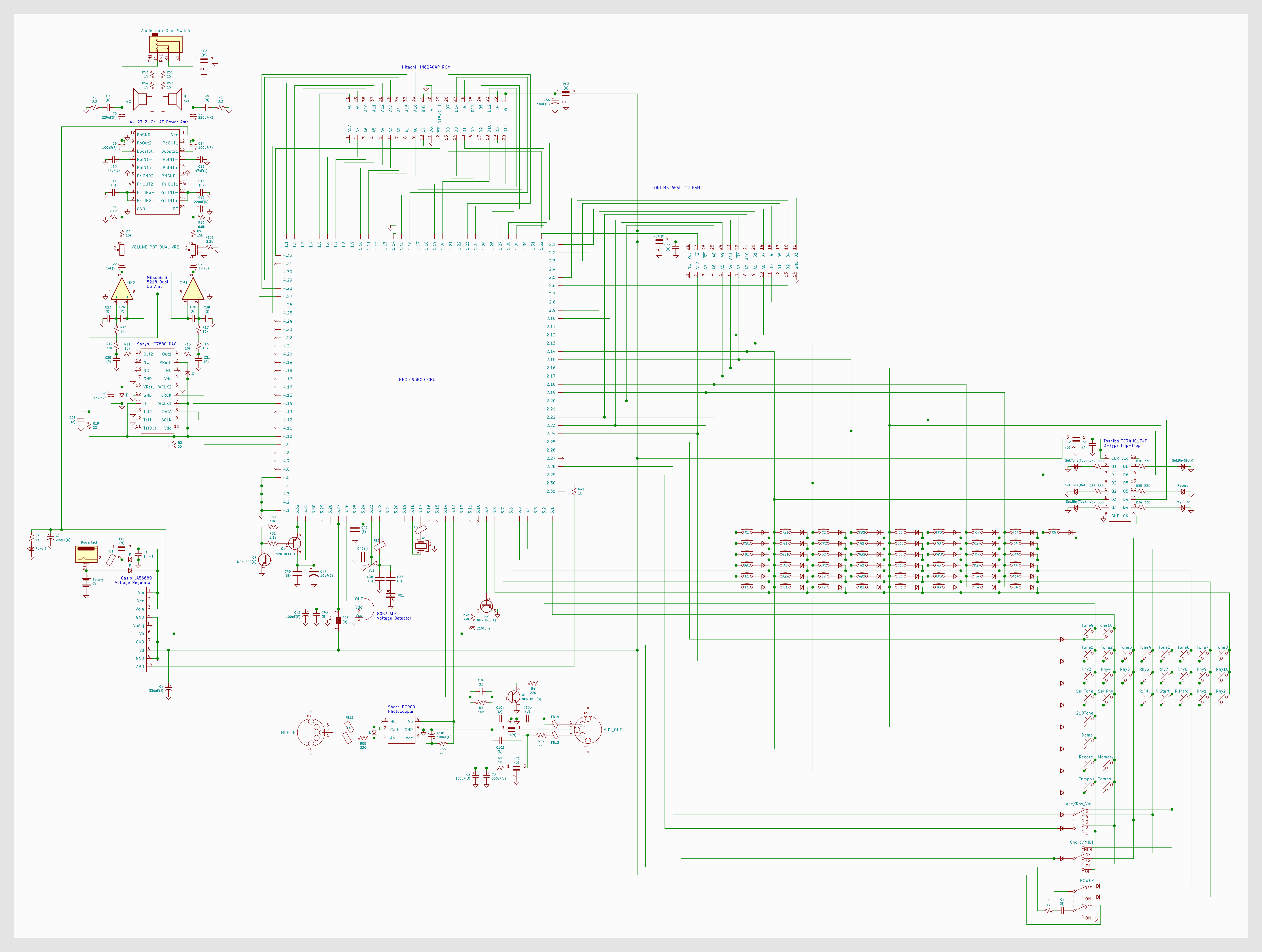

Power is distributed and regulated to the CPU and other ICs. A crystal oscillator sets the clock speed of the CPU. The CPU repeatedly scans for key and button presses through the keyboard and button matrices. An LC circuit determines the base frequency from which note pitches are derived. When the keyboard is played, synthesis programs begin and data is exchanged between the ROM and CPU, assembling a final PCM encoded waveform. The DAC converts it into an analog waveform, which is amplified in stages until it finally reaches the speakers. Additionally, the synth can send and receive midi data, record a short sequence of key presses in RAM, and uses a flip-flop to switch on LEDs. There are a few unsolved mysteries to me.
jPlugging the keyboard in with an AC adapter or batteries begins power supply to the voltage regulator chip, which distributes power to the other chips. Turning on the 'POWER' switch digitally enables the CPU. Meanwhile, the voltage detector chip regulates the current to the CPU.
A crystal oscillates at a frequency which determines the speed of the CPU cycles, setting the speed for how fast the CPU can run. Sonically, this affects things such as timbre, delay between LR channels, delay between parts of a sample, tremolo, vibrato, etc.
Imagine each note of the keyboard laid out in a matrix, with each note corresponding to a row & column. Pressing a key forms a momentary connection between a row & column of the matrix. The CPU detects this, and the corresponding note is produced. The 'Tone' and 'Rhythm' buttons also work this way in a separate matrix.
There are some empty spaces in both the keyboard and buttons matrices- 'easter eggs', hidden functions that the processor was designed to handle but were never implemented for the user. A hidden upper octave, 10 additional 'Tone' presets, and sustain pedal feature are the most interesting.
A circuit with a few capacitors and inductors oscillates at a frequency that determines the pitch of notes. I think the CPU uses this oscillator as the base frequency for all notes- by multiplying the base frequency by 2
Upon key press, the CPU and ROM begin exchanging data in a cycle with three simplified steps: 1.the ROM sends an address via 18 parallel Address(A) lines to the ROM chip; 2.the ROM then returns corresponding data back to the CPU across 16 parallel Data(D) lines; 3.the data is operated upon by the CPU. This cycle happens millions of times a second and does things like running stability programs, assembling and computing values (like amplitudes, durations, samples, etc, based on the 'TONE' preset selected), and finally encoding it into PCM (pulse code modulation) form for the DAC to synthesize.
Normally, this happens in a very regimented and prepared way- the programmers assemble the data in ROM to run smoothly and efficiently. Circuit bending the ROM by making external connections between the ROM-CPU lines completely changes the way the programs run and how data is interpreted. This leads to some very bizzarre musical effects and sounds, and is the heart of the circuit-bent MT-240.
Once the final PCM waveform is assembled, it is sent to a DAC, which synthesizes it into an analog signal. This signal is pretty quiet. First, it is amplified by an op amp system to a level that is only a little bit louder: to act as a buffer and so that it can be adjusted by a volume slider within reasonable margins. Then, it is put through a power amplifier IC where it reaches line level.
Finally, the signal passes by the on-board speakers. Alternatively, if something is plugged into the headphone jack, it bypasses the speaker line.
The CPU can also handle a small archaic MIDI system with a photocoupler IC. The Flip-Flop controls the LEDs toggled digitally by the CPU. The RAM can be used to record a short sequence of key presses. The mystery: a transistor system of unknown function.